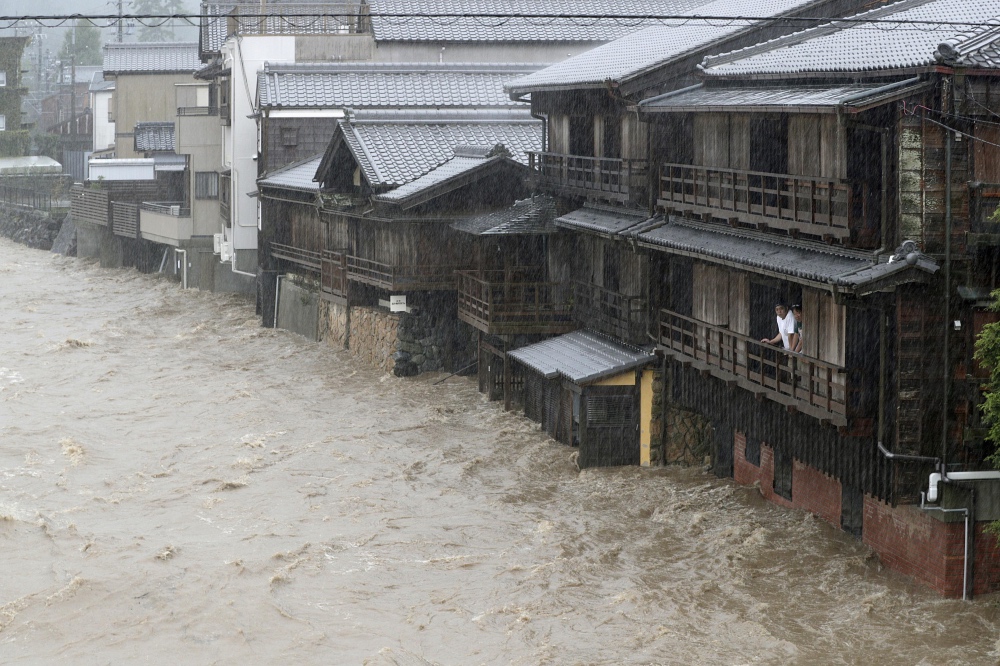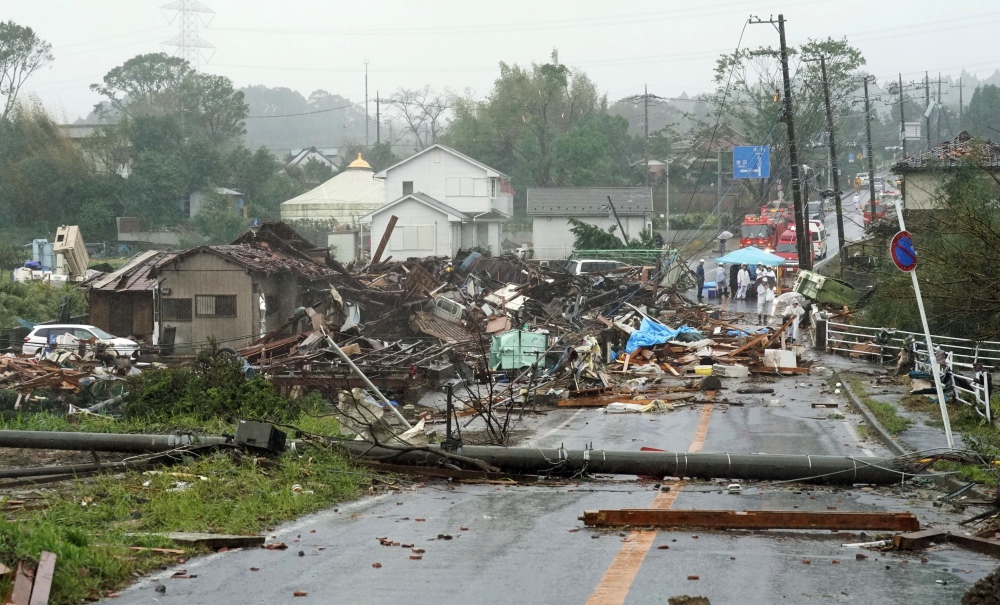Tokyo
Reuters
The most powerful typhoon to hit Tokyo in decades plowed into northern Japan early on Sunday after fierce rain and wind paralysed the capital, led to four deaths, millions under evacuation warnings, rivers flooded and normally busy streets deserted.
Authorities lifted rain and flood warnings for the Kanto region around a becalmed Tokyo before dawn on Sunday but imposed them on areas further north after Typhoon Hagibis blasted through the capital.

Men watch the swollen Isuzu River due to heavy rain caused by Typhoon Hagibis in Ise, central Japan, in this photo taken by Kyodo, on 12th October. PICTURE: Kyodo/via REUTERS
Attention focused on Fukushima, where Tokyo Electric Power Co overnight reported irregular readings from sensors monitoring water in its Fukushima Daiichi nuclear plant, which was crippled by the 2011 earthquake and tsunami.
Three people died in Chiba, Gunma and Kanagawa prefectures surrounding Tokyo, while a man in his 60s was found with no vital signs in a flooded apartment in Kawasaki, public broadcaster NHK said. Seventeen were missing early Sunday, it said.
A 50-year-old man was killed near Tokyo early on Saturday in a car overturned by punishing winds, while another person died after being washed away in a car, public broadcaster NHK said. Nine people remain missing in landslides and flooding, it said.
Authorities issued evacuation advisories and orders for more than 6 million people across the country as the storm unleashed the heaviest rain and winds in years. Some 80 injuries have been reported so far, while more than 270,000 households lost power, NHK said.
The storm, which the government said could be the strongest to hit Tokyo since 1958, brought record-breaking rainfall in many areas, including the popular resort town of Hakone, which was hit with 939.5 millimetres of rain over 24 hours.
Hagibis, which means “speed” in the Philippine language Tagalog, made landfall on Japan’s main island of Honshu on Saturday evening. A magnitude 5.7 earthquake shook Tokyo shortly after.
Major shinkansen bullet trains from Tokyo would begin on schedule Sunday, NHK said.
Even as the typhoon moved away from the capital late on Saturday, one expert warned of further flooding as several surrounding prefectures began releasing water from dams, letting it flow downstream.
“The situation is now worse than this evening,” Nobuyuki Tsuchiya, director of the Japan Riverfront Research Center, told Reuters. About 1.5 million people in Tokyo live below sea level.
The Japan Meteorological Agency issued the highest alert level for 12 prefectures, warning of potential for once in decades rain totals. It lifted the alerts early Sunday.
“Damage from floods and landslides is likely taking place already,” an agency official told a news conference carried by NHK. “It is critical that people take action urgently to protect their lives and the lives of loved ones.”

Destroyed houses, cars and power poles, which according to local media were believed to be caused by a tornado, are seen as Typhoon Hagibis approaches the Tokyo area in Ichihara, east of Tokyo, Japan, in this photo taken by Kyodo on 12th October. PICTURE: Kyodo/via REUTERS
Just last month, another strong storm, Typhoon Faxai, destroyed or damaged 30,000 houses in Chiba, east of Tokyo, and caused extensive power outages.
The capital’s main airports, Haneda and Narita, stopped flights from landing and connecting trains were suspended, forcing the cancellation of more than a thousand flights.
Train operators suspended bullet train services extensively, while many train and subway lines in Tokyo were also down for most of Saturday. Usually bustling entertainment and shopping districts such as Shibuya and Ginza were deserted.
Tokyo Disneyland was closed on Saturday, its first weather-related closure since 1984, and supermarkets ran out of bottled water, batteries and other disaster-related goods.
Many people in and around Tokyo took shelter in temporary evacuation facilities early, before the worst of the storm arrived.
Yuka Ikemura, a 24-year-old nursery school teacher, was in one such facility at a community centre in eastern Tokyo with her 3-year-old son, 8-month-old daughter and their pet rabbit.
She said she decided to move before it was too late.
“I’ve got small children to take care of and we live on the first floor of an old apartment,” Ikemura told Reuters.
“We brought with us the bare necessities. I’m scared to think about when we will have run out diapers and milk.”
Japanese Formula One Grand Prix organisers cancelled all practice and qualifying sessions scheduled for Saturday. Two matches of the Rugby World Cup due to be played on Saturday were also cancelled.
– Additional reporting by Chang-Ran Kim





